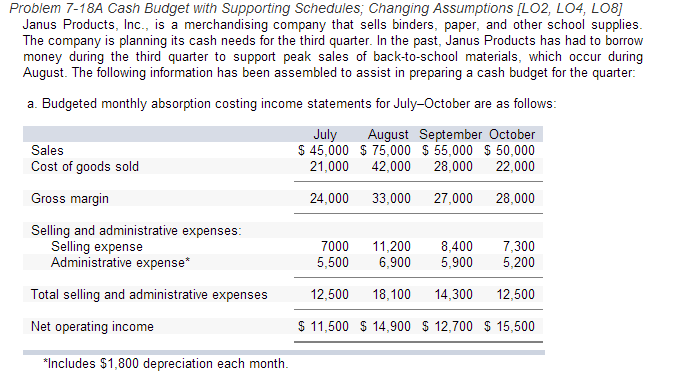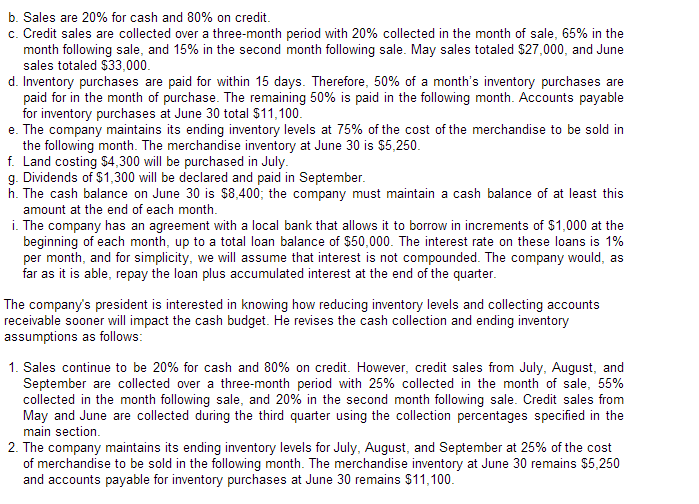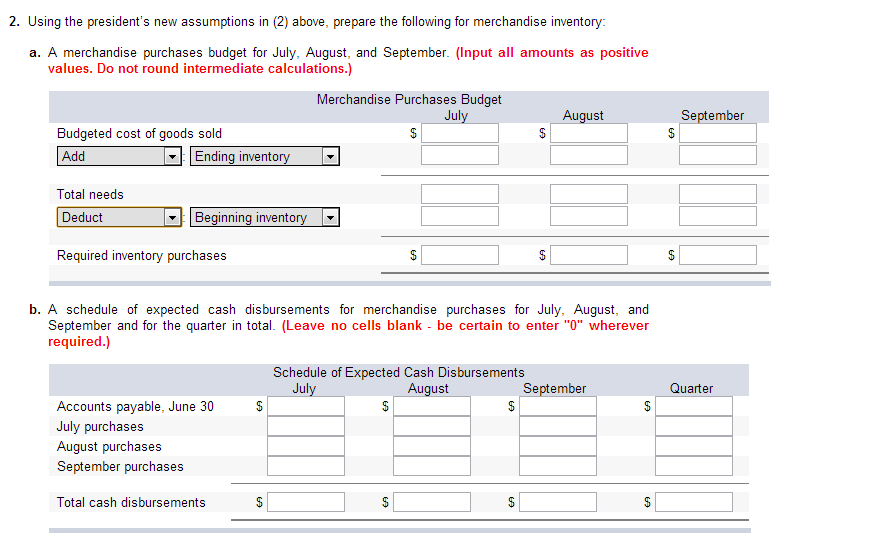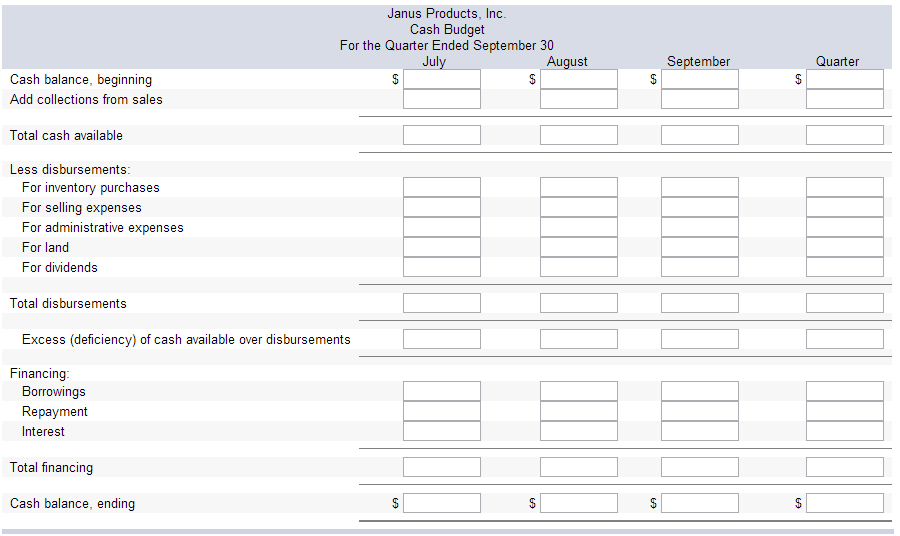





Janus Products, Inc., is a merchandising company that sells binders, paper, and other school supplies. The company is planning its cash needs for the third quarter. In the past, Janus Products has had to borrow money during the third quarter to support peak sales of back-to-school materials, which occur during August. The following information has been assembled to assist in preparing a cash budget for the quarter: Budgeted monthly absorption costing income statements for July-October are as follows: July August September October Sales $45,000 $75,00 $55,000 $50,000 Cost of goods sold 21,000 42,000 28,000 22,000 Gross margin 24,000 33,000 27,000 28,000 Selling and administrative expenses: Selling expense 7000 11,200 8,400 7,300 Administrative expense* 5,500 6,900 5,900 5,200 Total selling and administrative expenses 12,500 18,100 14,300 12,500 Net operating income $11,500 $14,900 $12,700 $15,500 *Includes $1,800 depreciation each month. Sales are 20% for cash and 80% on credit. Credit sales are collected over a three-month period with 20% collected in the month of sale, 65% in the month following sale, and 15% in the second month following sale. May sales totaled $27,000, and June sales totaled $33,000. Inventory purchases are paid for within 15 days. Therefore, 50% of a month's inventory purchases are paid for in the month of purchase. The remaining 50% is paid in the following month. Accounts payable for inventory purchases at June 30 total $11,100. The company maintains its ending inventory levels at 75% of the cost of the merchandise to be sold in the following month. The merchandise inventory at June 30 is $5,250. Land costing $4,300 will be purchases in July. Dividends of $1,300 will be declared and paid in September. The cash balance on June 30 is $8,400; the company must maintain a cash balance of at least this amount at the end of each month. The company has an agreement with a local bank that allows it to borrow in increments of $1,000 at the beginning of each month, up to a total loan balance of $50,000. The interest rate on these loans is 1% per month, and for simplicity, we will assume that interest is not compounded. The company would, as far as it is able, repay the loan plus accumulated interest at the end of the quarter The company's president is interested in knowing how reducing inventory levels and collecting accounts receivable sooner will impact the cash budget. He revises the cash collection and ending inventory assumptions as follows: Sales continue to be 20% for cash and 80% on credit. However, credit sales from July, August, and September are collected over a three-month period with 25% collected in the month of sale, 55% collected in the month following sale, and 20% in the second month following sale. Credit sales from May and June are collected during the third quarter using the collection percentages specified in the main section. The company maintains its ending inventory levels for July, August, and September at 25% of the cost of merchandise to be sold in the following month. The merchandise inventory at June 30 remains $5,250 and accounts payable for inventory purchases at June 30 remains $11,100. Using the president's new assumptions in (1) above, prepare a schedule of expected cash collections for July, August, and September and for the quarter in total. (Leave no cells blank - be certain to enter "0" wherever required. Do not round intermediate calculations.) Schedule of Expected Cash Collection July August September Quarter Cash sales $9000 $15000 $11000 $35000 Credit sales: May June July August September Total cash collections $ $ $ $ Using the president's new assumptions in (2) above, prepare the following for merchandise inventory: A merchandise purchases budget for July, August, and September. (Input all amounts as positive values. Do not round intermediate calculations.) Merchandise Purchases Budget July August September Budgeted cost of goods sold $ $ $ Add Ending inventory Total needs Deduct Beginning inventory Required inventory purchases $ $ $ A schedule of expected cash disbursements for merchandise purchases for July, August, and September and for the quarter in total. (Leave no cells blank - be certain to enter "0" wherever required.) Schedule of Expected Cash Disbursements July August September Quarter Accounts payable, June 30 $ $ $ $ July purchases August purchases September purchases Total cash disbursements $ $ $ $ Using the president's new assumptions, prepare a cash budget for July, August, September, and for the quarter in total. Assume that selling expenses and general and administrative expenses are paid in the month incurred. (Input all amounts as positive values. Leave no cells blank - be certain to enter "0" wherever required. Total Financing should be indicated with a minus sign when the company is repaying amounts that were previously borrowed.) Janus Products, Inc. Cash Budget For the Quarter Ended September 30 July August September Quarter Cash balance, beginning $ $ $ $ Add collections from sales Total cash available Less disbursements: For inventory purchases For selling expenses For administrative expenses For land For dividends Total disbursements Excess (deficiency) of cash available over disbursements Financing: Borrowings Repayment Interest Total financing Cash balance, ending $ $ $ $ Janus Products, Inc., is a merchandising company that sells binders, paper, and other school supplies. The company is planning its cash needs for the third quarter. In the past, Janus Products has had to borrow money during the third quarter to support peak sales of back-to-school materials, which occur during August. The following information has been assembled to assist in preparing a cash budget for the quarter: Budgeted monthly absorption costing income statements for July-October are as follows: July August September October Sales $45,000 $75,00 $55,000 $50,000 Cost of goods sold 21,000 42,000 28,000 22,000 Gross margin 24,000 33,000 27,000 28,000 Selling and administrative expenses: Selling expense 7000 11,200 8,400 7,300 Administrative expense* 5,500 6,900 5,900 5,200 Total selling and administrative expenses 12,500 18,100 14,300 12,500 Net operating income $11,500 $14,900 $12,700 $15,500 *Includes $1,800 depreciation each month. Sales are 20% for cash and 80% on credit. Credit sales are collected over a three-month period with 20% collected in the month of sale, 65% in the month following sale, and 15% in the second month following sale. May sales totaled $27,000, and June sales totaled $33,000. Inventory purchases are paid for within 15 days. Therefore, 50% of a month's inventory purchases are paid for in the month of purchase. The remaining 50% is paid in the following month. Accounts payable for inventory purchases at June 30 total $11,100. The company maintains its ending inventory levels at 75% of the cost of the merchandise to be sold in the following month. The merchandise inventory at June 30 is $5,250. Land costing $4,300 will be purchases in July. Dividends of $1,300 will be declared and paid in September. The cash balance on June 30 is $8,400; the company must maintain a cash balance of at least this amount at the end of each month. The company has an agreement with a local bank that allows it to borrow in increments of $1,000 at the beginning of each month, up to a total loan balance of $50,000. The interest rate on these loans is 1% per month, and for simplicity, we will assume that interest is not compounded. The company would, as far as it is able, repay the loan plus accumulated interest at the end of the quarter The company's president is interested in knowing how reducing inventory levels and collecting accounts receivable sooner will impact the cash budget. He revises the cash collection and ending inventory assumptions as follows: Sales continue to be 20% for cash and 80% on credit. However, credit sales from July, August, and September are collected over a three-month period with 25% collected in the month of sale, 55% collected in the month following sale, and 20% in the second month following sale. Credit sales from May and June are collected during the third quarter using the collection percentages specified in the main section. The company maintains its ending inventory levels for July, August, and September at 25% of the cost of merchandise to be sold in the following month. The merchandise inventory at June 30 remains $5,250 and accounts payable for inventory purchases at June 30 remains $11,100. Using the president's new assumptions in (1) above, prepare a schedule of expected cash collections for July, August, and September and for the quarter in total. (Leave no cells blank - be certain to enter "0" wherever required. Do not round intermediate calculations.) Schedule of Expected Cash Collection July August September Quarter Cash sales $9000 $15000 $11000 $35000 Credit sales: May June July August September Total cash collections $ $ $ $ Using the president's new assumptions in (2) above, prepare the following for merchandise inventory: A merchandise purchases budget for July, August, and September. (Input all amounts as positive values. Do not round intermediate calculations.) Merchandise Purchases Budget July August September Budgeted cost of goods sold $ $ $ Add Ending inventory Total needs Deduct Beginning inventory Required inventory purchases $ $ $ A schedule of expected cash disbursements for merchandise purchases for July, August, and September and for the quarter in total. (Leave no cells blank - be certain to enter "0" wherever required.) Schedule of Expected Cash Disbursements July August September Quarter Accounts payable, June 30 $ $ $ $ July purchases August purchases September purchases Total cash disbursements $ $ $ $ Using the president's new assumptions, prepare a cash budget for July, August, September, and for the quarter in total. Assume that selling expenses and general and administrative expenses are paid in the month incurred. (Input all amounts as positive values. Leave no cells blank - be certain to enter "0" wherever required. Total Financing should be indicated with a minus sign when the company is repaying amounts that were previously borrowed.) Janus Products, Inc. Cash Budget For the Quarter Ended September 30 July August September Quarter Cash balance, beginning $ $ $ $ Add collections from sales Total cash available Less disbursements: For inventory purchases For selling expenses For administrative expenses For land For dividends Total disbursements Excess (deficiency) of cash available over disbursements Financing: Borrowings Repayment Interest Total financing Cash balance, ending $ $ $ $












